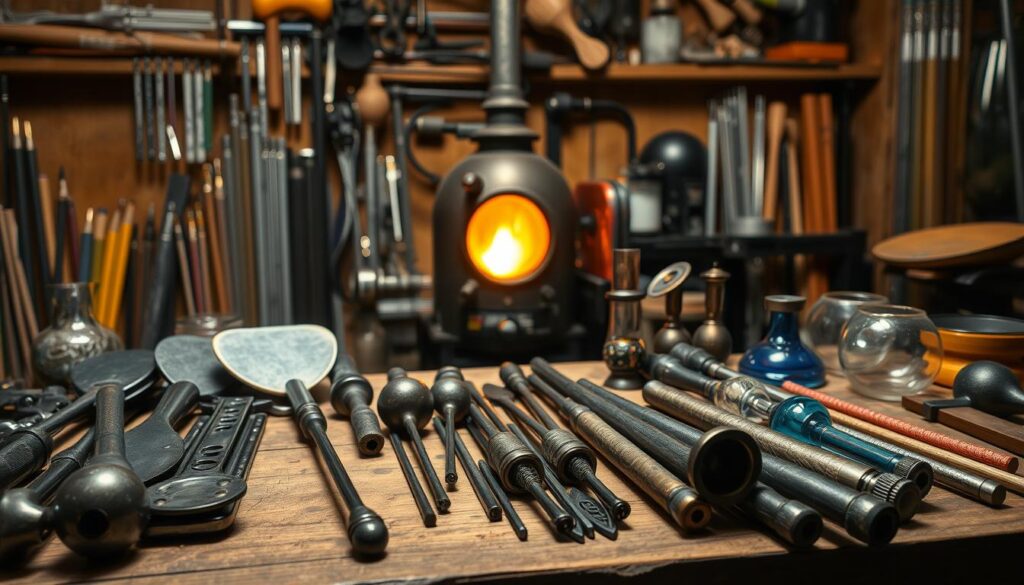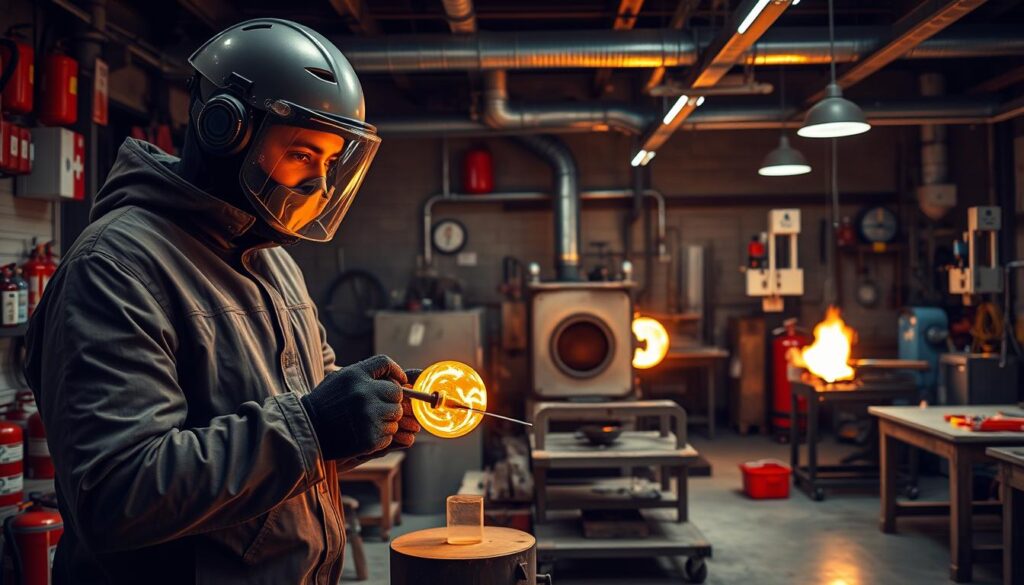Glassblowing is a transformative art form that involves shaping molten glass into stunning creations. This ancient craft combines skill and patience, offering a unique blend of creativity and precision. Whether you’re drawn to functional pieces like wine glasses or intricate sculptures, glassblowing provides endless possibilities.
Modern studios make this art form accessible to enthusiasts of all levels. With over 400 studios operating across the United States, you can explore this craft in a supportive environment. Tools like the blowpipe and furnace are essential for manipulating molten glass, which is worked at temperatures around 2,100°F.
Shows like Netflix’s “Blown Away” highlight the creative potential of glassblowing. This meditative practice combines physics and artistry, making it a rewarding experience. Discover the versatility of blown glass and immerse yourself in this captivating process.
For more insights, visit The Crucible’s glassblowing guide to dive deeper into this fascinating craft.
What is Glassblowing and Why Should You Try It?
The craft of shaping molten glass has fascinated artisans for centuries. This art form combines creativity, precision, and a deep understanding of materials. Whether you’re drawn to its historical roots or its modern applications, glassblowing offers a unique blend of challenge and reward.
The History and Art of Glassblowing
Glassblowing began around 50 BCE in the Levant region, where Phoenician artisans first used a hollow metal tube to shape molten glass. The Roman Empire later adopted and refined these techniques, spreading the craft across Europe and beyond. By the medieval period, Venetian glassmakers perfected cristallo, a clear and durable glass that became highly prized.
In the 20th century, the studio glass movement, led by Harvey Littleton, revived interest in this ancient craft. Today, glassblowing is celebrated for its versatility, from scientific glassware to iconic Tiffany lamps. Its rich history continues to inspire modern artists like Dale Chihuly and Lino Tagliapietra.
| Period | Key Development |
|---|---|
| 1st Century BCE | Phoenician artisans invent glassblowing |
| Roman Empire | Industrial-scale production using blowpipes |
| Medieval Venice | Innovations like cristallo and optic molds |
| 1960s | Studio glass movement revives the craft |
Why Glassblowing is a Rewarding Craft
Glassblowing is more than just an art form; it’s a therapeutic and immersive experience. Studies show that 78% of beginners report reduced stress levels after their first session. The process of transforming molten glass into a permanent creation is both meditative and exhilarating.
This craft also offers physical and cognitive benefits. It enhances hand-eye coordination and sharpens your perception of temperature and materials. For those interested in exploring other glass-related crafts, check out this guide on stained glass as a timeless art.
Whether you’re creating functional pieces or intricate sculptures, glassblowing allows you to express your creativity in a tangible way. Its unique blend of skills and artistry makes it a rewarding pursuit for anyone seeking a new challenge.
Essential Tools and Equipment for Glassblowing
From blowpipes to furnaces, each tool plays a vital role in glassblowing. These tools have evolved over centuries, blending tradition with modern innovation. Whether you’re a beginner or a seasoned artist, understanding their functions is key to mastering this craft.

Understanding the Blowpipe and Furnace
The blowpipe is a hollow metal tube, typically 4-5 feet long, used to gather and shape molten glass. It consists of a mouthpiece, gathering end, and punty joint. This essential tool allows you to blow air into the glass, creating the desired form.
The furnace is equally important, maintaining temperatures around 2,100°F to keep the glass molten. There are three main types: glory holes, crucible furnaces, and pot furnaces. Each serves a specific purpose, from reheating to melting raw materials.
Other Key Tools: Marver, Jacks, and Shears
The marver is a steel table used to roll and shape the glass. This technique, known as marvering, helps create smooth surfaces and even shapes. It’s a critical step in the glassblowing process.
Jacks are versatile tools with dual functions. They shape necks and create handles, offering precision in design. Shears, on the other hand, are used for cutting hot glass. Specialized shears ensure clean cuts, whether for hot or coldworking.
Safety is paramount in a glassblowing studio. Essential protective gear includes IR-protective eyewear and Kevlar sleeves. Regular maintenance, like daily furnace checks and seasoning graphite tools, ensures longevity and safety.
How to Get Started with Glass Blowing at a Local Studio
Discovering the art of glassblowing begins with finding the right studio. A supportive environment can make all the difference for beginners. Start by searching online directories like the Glass Art Society (GAS) or using Yelp filters to locate nearby options. Many studios offer introductory classes, ranging from taster sessions to 8-week fundamentals.
Finding a Glassblowing Studio Near You
Look for studios with experienced instructors and a focus on safety. Notable schools like the Corning Museum, Pilchuck, and UrbanGlass are excellent starting points. Check reviews and visit their websites to understand their offerings. Most studios provide beginner-friendly workshops, such as “make your own ornament,” which are perfect for first-timers.
What to Expect in Your First Glassblowing Class
Your first glassblowing class will likely last 3 hours and cost between $150-$300. Wear natural fibers and closed-toe shoes for safety. Stay hydrated, as working with molten glass can be physically demanding. Your instructor will guide you through basic techniques, such as gathering molten glass and shaping it into simple forms like paperweights or drinking vessels.
Classes typically maintain a 4:1 student-to-instructor ratio to ensure personalized attention. Be prepared to follow studio etiquette, including cleaning your workstation and handling tools properly. Common beginner mistakes include overheating the glass or uneven rotation, but your instructor will help you avoid these pitfalls.
After your class, many studios offer open studio hours or mentorship programs for further practice. This allows you to refine your skills and explore more advanced techniques. Whether you’re creating functional pieces or intricate designs, the experience of glassblowing is both rewarding and transformative.
Safety Tips and Best Practices for Beginners
Ensuring safety is the foundation of mastering glassblowing. This craft involves working with extreme heat and delicate materials, making it essential to follow strict protocols. Whether you’re a novice or an experienced artist, prioritizing safety ensures a smooth and enjoyable process.

Protective Gear and Studio Safety
Wearing the right heat-resistant gear is crucial. Didymium glasses protect your eyes from sodium glare, while aluminized aprons shield your body from heat. Nomex gloves and steel-toe boots safeguard your hands and feet from burns and injuries.
Proper ventilation is another key aspect. Studios must maintain a minimum of 100 CFM per square foot to remove harmful fumes. Color-coded zones help distinguish between hot and cold areas, reducing the risk of accidents.
| Safety Gear | Purpose |
|---|---|
| Didymium Glasses | Blocks sodium glare |
| Aluminized Aprons | Shields body from heat |
| Nomex Gloves | Protects hands from burns |
| Steel-Toe Boots | Prevents foot injuries |
Handling Molten Glass Safely
Working with molten glass requires precision and caution. Always maintain a safe distance of at least 18 inches from glory holes. Recognize the difference between “sticky” and “liquid” glass states to avoid overheating or mishandling.
In case of burns, cool the affected area immediately with water—never use ice. Studios should have fire blankets and eyewash stations readily accessible. Hydration breaks every 45 minutes are essential, especially in hot shops.
By following these techniques, you can minimize risks and focus on honing your skills. Safety is not just a guideline—it’s a necessity in the world of glassblowing.
Conclusion: Embark on Your Glassblowing Journey
Embarking on the journey of glassblowing opens doors to a world of creativity and precision. Mastering key skills like gathering, blowing, and annealing lays the foundation for your growth in this craft. Whether you explore lampworking or architectural glass, each path offers unique challenges and rewards.
The glassblowing community thrives on collaboration and innovation. From glass swaps to Instagram challenges, connecting with fellow artists enhances your learning experience. Resources like GAS membership and Glass Quarterly subscriptions provide valuable insights and inspiration.
Local highlights, such as the Museum of Glass in Tacoma or the Niijima Festival, celebrate the art of blown glass. Remember to respect the material’s transformative power and prioritize safety in every practice session.
Ready to take the next step? Book an introductory workshop at a glass studio near you and continue your glassblowing adventure today.
